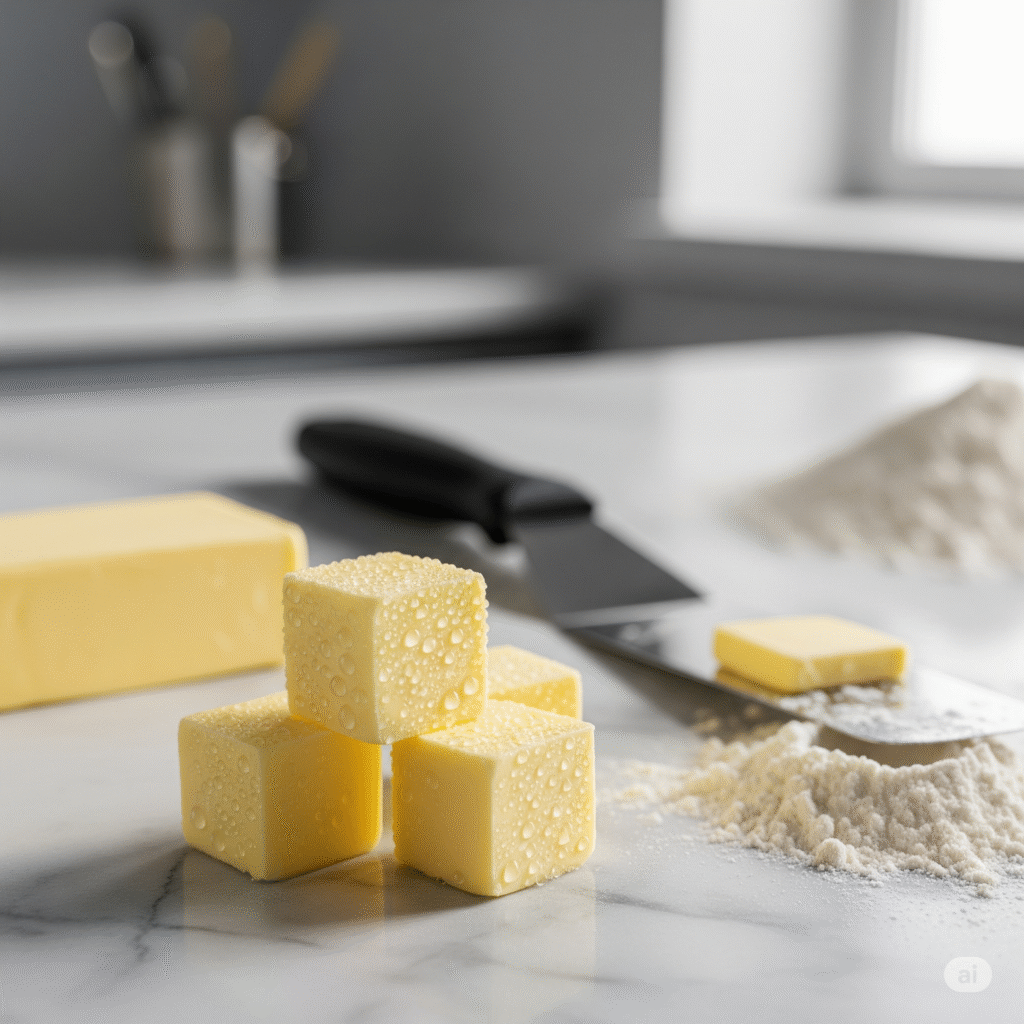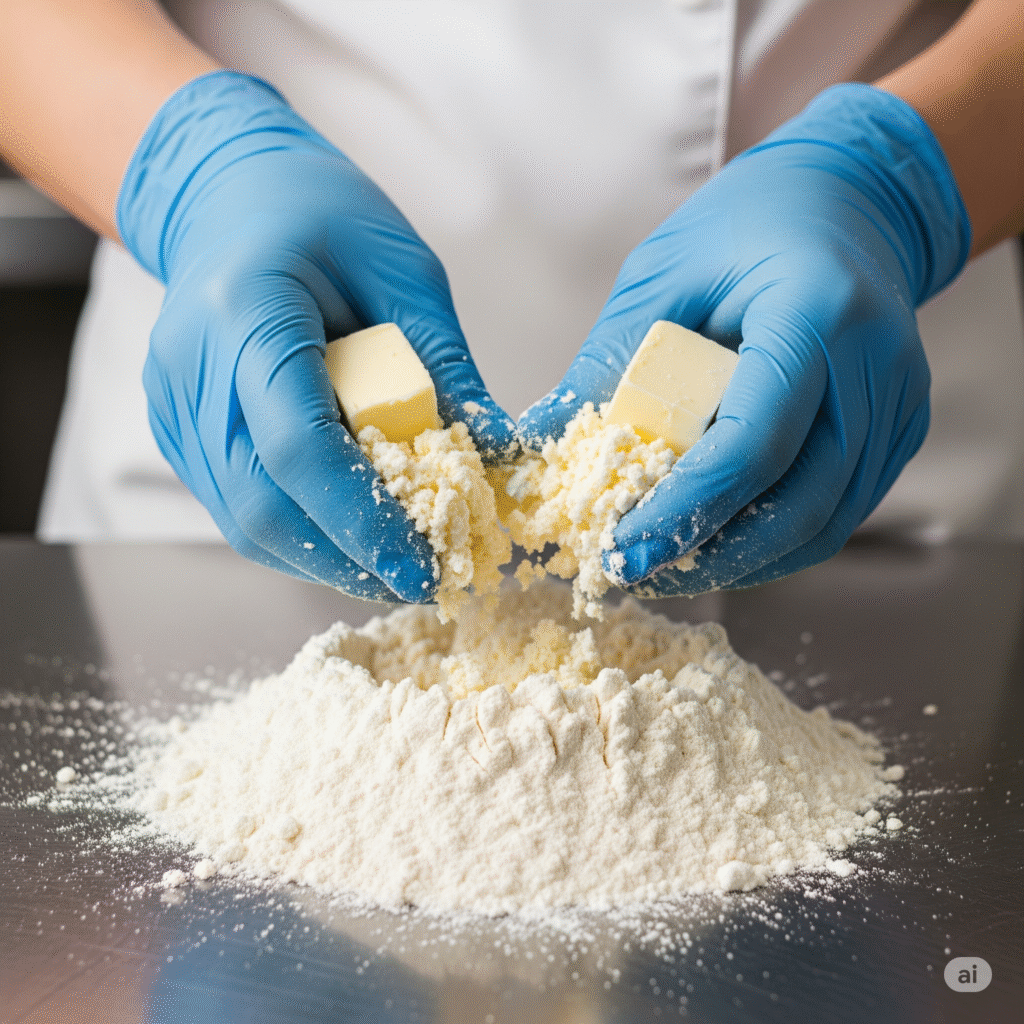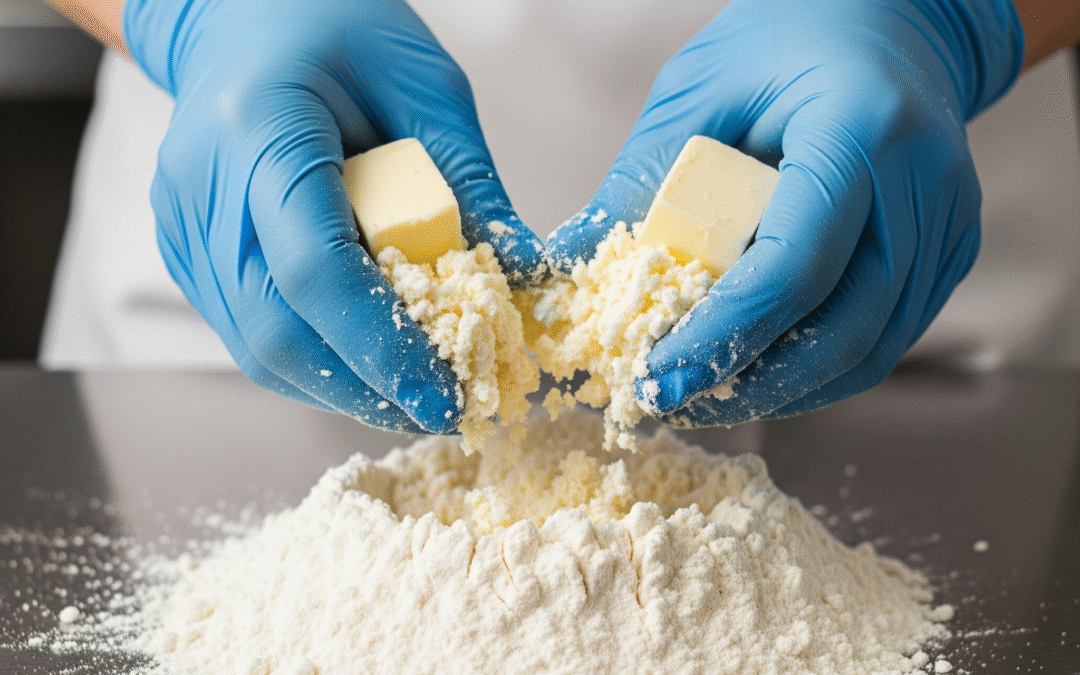Is the Summer Heat Sabotaging Your Pastry? The Science of Mastering Fats
Mastering fats in pastry is the key to success when the summer heat turns your kitchen into a challenge. We all dream of a fragrant puff pastry or a melt-in-your-mouth shortcrust, but true control lies in understanding the science of our ingredients. This guide puts your most heat-sensitive ingredient under the lens, showing you exactly how to take control.
By Katia Oldani | Aug 5, 2025 | Ingredient Spotlight
The Technical Eye: The Science of Mastering Fats in Pastry
Fats are the soul of many doughs, responsible for flavor, flakiness, and structure. Their behavior is dictated by precise scientific principles, which the heat puts to the test.

The first sign of trouble: butter’s fat crystals beginning to melt as the temperature rises.
The Melting Range: A Fat’s Identity
Every fat doesn’t have a single melting point, but a melting range. Butter, a complex mixture of fats, begins to soften at just 20°C (68°F) and becomes liquid around 32-35°C (90-95°F). Its plasticity—the ability to be shaped without fracturing—exists only within this range. Summer heat quickly pushes butter beyond its plastic threshold, compromising lamination or the texture of your shortcrust.
Crystallization: The Invisible Architecture of Texture
A solid fat is an ordered structure of crystals. Their shape and size (polymorphism) are crucial. The small, stable β’ (Beta-prime) crystals, typical of good quality butter, are our best friends for achieving a smooth texture. Heat melts them, and an uncontrolled cooling can promote recrystallization into larger, grainier β (Beta) crystals, which create an unpleasant, sandy mouthfeel.
Emulsions: A Delicate Balance
In buttercreams or ganaches, fats are part of a stable emulsion. Heat provides energy, agitates the molecules, and can break the delicate balance between the fat and water phases, causing phase separation (a “broken” or “split” emulsion).
The “Shortening” Effect: The Principle of Flakiness
In doughs like shortcrust, fat performs a “waterproofing” function known as the shortening effect. Its molecules coat the flour proteins (gluten), preventing them from forming strong bonds when water is added. This makes the dough tender and “short.” If the butter melts due to heat, this effect is drastically reduced, a key challenge when you are trying to master this topic.

Science at work: fat molecules create a waterproof barrier around flour proteins, which is the key to a perfectly “short” and flaky dough.
In Practice: Mastering Fats in Pastry with Scientific Solutions
Armed with this knowledge, we can tackle the most common issues. Here are practical solutions for when the temperature rises.
Problem: “My summer shortcrust ‘sweats’ oil and loses its shape in the oven.”
- Solution: Work with very cold ingredients (butter, eggs, liquids). Use your fingertips or a stand mixer to avoid warming the dough. Crucially, after pressing the dough into your pan, place it in the freezer for 15-20 minutes before baking. This thermal shock will help “set” the fat, ensuring a flaky texture and a perfect shape.
Problem: “I want to make croissants, but the butter leaks out during lamination and the dough becomes sticky.”
- Solution: The secret is temperature control and resting periods. Between each “turn” or “fold,” wrap the dough in plastic wrap and let it rest in the refrigerator for at least 30-40 minutes. This allows the butter to re-solidify and the gluten to relax. If it’s very hot, consider using a professional laminating butter or anhydrous butter, which have a higher melting point.
Problem: “My buttercream has split and turned watery.”
- Solution: The emulsion has broken due to heat. Try placing the bowl with the cream in the refrigerator for 10-15 minutes, stirring occasionally, until the edges begin to firm up. Then, put it back on the stand mixer and whip it again at low-medium speed. The cold will help re-establish the correct emulsion.
Pro-Tip: Leveraging Anhydrous Butter (Ghee)
For the most challenging summer shortcrusts, try replacing a small portion (20-30%) of the butter with anhydrous butter or ghee. Being almost entirely free of water, it has a higher melting point and greater stability. It will add a subtle nutty flavor and give you extra workability without having to resort to vegetable margarines.
Conclusion: Mastering Fats in Pastry is Your Secret Ingredient
Ultimately, understanding the science behind the ingredients is a key part of mastering fats in pastry, especially in summer. This knowledge moves beyond simple recipes and empowers you to adapt and succeed.
The next time you pick up a block of cold butter, I hope you’ll see it with new eyes—not just as an ingredient, but as a powerful ally that, when understood, will grant you extraordinary results in any condition.
Now it’s your turn! What’s the biggest challenge you face when working with fats in the summer? Let me know in the comments below—let’s build our #HonestBaking community together!
Katia Oldani, Biologist Pastry Chef
Visit my YouTube Channel for videos and more insights.
For any information or to get in touch, click here.


